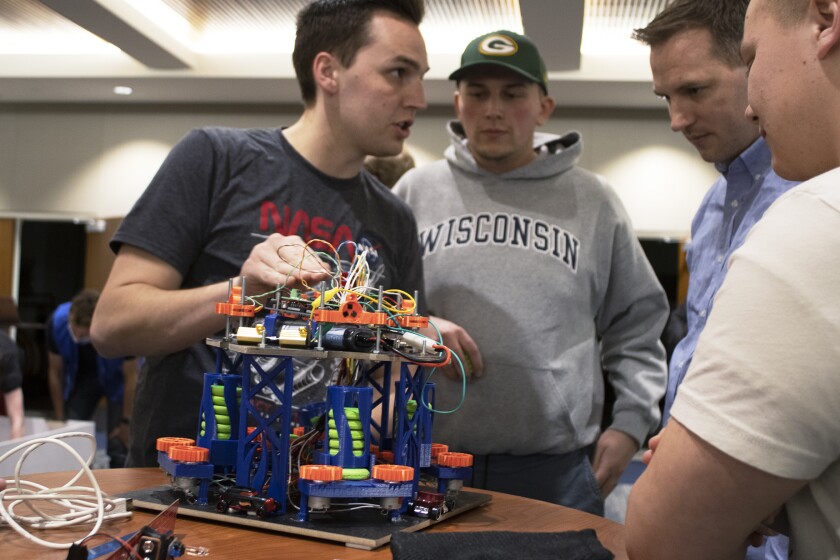
The third-semi-annual Mountain West Robotics Competition went down Friday, Dec. 10, with Team Lights Out beating out six competitors for the grand prize of $400.
The object of the competition was for each team’s robot to hit the correct sequence of six buttons before time ran out. The sequence varied each time, and successful robots required both accurate sensing and speed. Whichever team accomplished the task with the fewest penalties and shortest amount of time would win.
“So there’s a sensing element–they’ve got to sense an LED–and then a mechanical element, where they have to somehow activate that button or switch,” commentator Dr. Ryan Camacho said.
Competitors included Bob Saget Dynamics (second place), Ground Control (third place), Absolute Hack (fourth place), Void Build a Robot (fifth place), Team Beth (sixth place), and the Sea Armadillos (seventh place).
Bob Saget held the lead for the first half with their nerf-wielding robot. The machine remained in the center of the arena and shot nerf discs at the respective buttons, coming in with a quick 1,110 millisecond time. A penalty for hitting the button twice brought their score to 1,220.
The team included two computer engineering doctoral students, a manufacturing engineering undergraduate, and a mechanical engineering undergraduate, three of whom were roommates.
“The key to our success was having software guys and hardware guys,” the team spokesman said.
Bob Saget had a 1.4 second lead until Lights Out pulled ahead and stole a 1,205 millisecond time with zero penalties in the second round. Their robot, Black Widow, used four spring-loaded arms that sprawled over the arena and ended in little levers for pushing the buttons. They were the first team to score zero penalties, but their 1,361 millisecond time put them in second place.
They fidgeted with the springs and ran their riskier code for the second round. The risk paid off and pulled them into first place.
“It’s faster—a little bit—and a little bit was enough so far,” spokesman Parker Awerkamp said.
Lights Out included one electrical engineering doctoral student, an electrical engineering junior, and a married couple consisting of electrical engineering and psychology graduate students.
Ground Control came in third place. They employed a similar strategy to Lights Out, with accordion arms that sprawled out and pushed the buttons as needed. The accordion arms failed to engage during their first round, but pulled into second place during the second round with a 1,476 millisecond time and two penalties.
Other notable strategies Absolute Hack’s squad of four robots and Team Beth and Void Build a Robot’s single roving robots. The Sea Armadillos entered the competition at the last minute with a day-old robot composed of pieces of wood and number two pencils.
“We thought we would just do it for fun, you know,” the Sea Armadillos spokesman said. “We did put most of it together today.”
Every participating team received a t-shirt, pizza, and the opportunity to visit with Vice-President Bryan Heslop from Endigit.
Bryan praised the winning robot’s designs: “Some of them are designed to be as simple as possible, and I think that’s helpful. The fewer moving parts and complications with things, the fewer things can go wrong, and it makes it simple to achieve the task.”
Students will have the chance to build more robots and compete for prizes anew in next semester’s competition: Crystal Cavern Chaos. Competition sponsor Texas Instruments provides the teams with kits and sensors to get started. Interested students can contact Michael Eyler at michael.eyler@byu.edu for more information.

